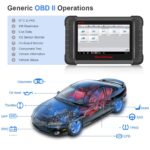Understanding the VCDS user interface is crucial for effective vehicle diagnostics. This guide provides a detailed overview of the interface and its identification features, enabling users to navigate the software and personalize their experience.
Navigating the VCDS Options Screen
The VCDS Options screen allows for customization of various settings, categorized into tabbed sections. These settings are essential for initial setup and ongoing use. Let’s delve into each section:
Port and Protocol Options: Establishing Communication
Selecting the Right Port:
This section dictates the communication pathway between your computer and the vehicle’s diagnostic port. Choose the correct COM port (typically COM1 for serial connections) or the designated USB port for USB interfaces. With the ignition on and the interface connected, click the [Test] button to verify connectivity. The test results will vary based on your interface:
- HEX-NET HEX-V2: Expect “Testing” or “OK” for CAN, K1, K2, battery voltage (Vbat), and ignition voltage (VIgn).
- HEX-USB+CAN/HEX-COM+CAN: Anticipate “OK” for K1, K2, and CAN (if the vehicle supports it). “Not Ready” for CAN indicates the car lacks CAN capabilities.
- Older Interfaces (KII-USB, KEY-USB, KEY-COM, HEX-USB, HEX-COM): K1 and K2 should show “OK,” while CAN will display “Not Supported.”
- Micro-CAN: K1 and K2 are “Not Supported,” while CAN should be “OK” on Mk5-based vehicles.
“Short to Ground” or “Short to +12V” errors necessitate checking the vehicle’s diagnostic port using guidelines found on the Aftermarket Radio Page.
The [LEDs] button on older interfaces triggers LED blinking for troubleshooting connection problems. The [Config] button on HEX-NET or HEX-V2 launches the VCDS Interface Config utility for firmware updates, registration, and WiFi configuration.
Fine-tuning Protocol Options:
Advanced users can adjust protocol settings for specific needs. However, changing these parameters from their defaults is generally discouraged unless troubleshooting communication issues under the guidance of Ross-Tech:
- Start Baud: Automatically determined by VCDS (default value 0).
- KW2 Delay: Initialization time (default 30).
- TST Addr.: Packet addresses for KWP-2000 (default -1).
- Debug Level: Controls debugging information (default 0 – no output).
- Blk Int/Char Int/Char Int 2K: Impact protocol timing and data sample rates (defaults vary by interface).
- KP2 Time: Affects KWP-2000 sample rates (default 25).
- CAN Timeout: Response wait time (default 0).
Initialization Parameters:
These settings should generally remain at their defaults unless specific connection problems arise:
- Bypass OBD-II Fastinit: Use only for OBD-II connection difficulties.
- Force K on Engine: Forces communication via K-line on compatible engine controllers.
- Bypass CAN Init: Prevents CAN connection attempts.
- Boot in intelligent mode/Forced Dumb Mode: Determines interface behavior (default checked for intelligent mode/unchecked for Forced Dumb Mode).
Optimizing CPU Usage:
Reduce CPU load by checking the Reduce CPU Usage boxes for KWP-1281 and KWP-2000, potentially at the cost of reduced sample rates.
The [Restore Defaults] button resets all Protocol Options to their original settings. Right-clicking the VCDS icon and selecting “Delete config file and close” resets the window size and other settings.
User Interface and Identification: Personalizing VCDS
Workshop Identification:
- Shop Name: Displays on reports.
- WorkShop Code (WSC): Use your dealer’s code if applicable; otherwise, leave as 00000 for stealth mode.
- VZ/Importer Number: Region code (444 for US, 999 for Canada; otherwise, 000).
- Equipment Number: Used for coding new modules (default 00000).
Customizing the User Interface:
- Left Margin Printing: Adjusts print margins.
- Window Size: Resize the VCDS window.
- Disable Sounds: Turns off operation completion sounds.
- Prevent screen power savings while communicating: Keeps the screen active during diagnostics.
- Build list of CAN controllers prior to selection dialog: Enables automatic population of installed modules (default checked).
Managing Updates:
The Check for free updates section lets you control automatic update checks. Choose your preferred frequency or manually check for updates using the [Check for updates now] button.
Finally, use the [Save] button to store changes, [Apply] to test without saving, and [Cancel] to discard changes. This comprehensive understanding of the Vcds User Interface And Identification options empowers users to effectively utilize the software for vehicle diagnostics and customization.

